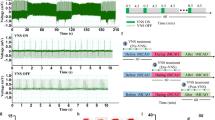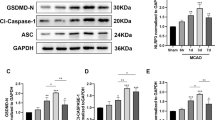Abstract
Microglia play an essential role during cerebral an ischemia/reperfusion (I/R)-related inflammatory process. Because the M2 phenotype of microglia exhibits anti-inflammation activity, it has become a promising target for anti-inflammatory therapy. Vagus nerve stimulation (VNS) reportedly has neuroprotective effects against cerebral I/R injuries via its anti-inflammatory action. The aim of this study was to investigate the ability of non-invasive VNS (nVNS) to alleviate cerebral I/R in mice by promoting microglial M2 polarization. Neurological scoring and cerebral infarct volume assessments were performed 72 h after a middle cerebral artery occlusion (MCAO)-induced stroke. M2 phenotype microglia were identified by immunohistochemistry staining using Arg-1 and Iba-1 antibodies. The protein expressions of Arg-1, IL-17A, IL-10, Bax, and Bcl-2 were detected by Western blot. Apoptotic cells were detected using TUNEL staining. According to our results, nVNS decreased infarct volume, improved neurological outcomes, reduced apoptotic neurons (TUNEL+NeuN+ cells), and promoted microglial M2 polarization as indicated by elevated Arg-1 protein expression and increased Arg-1+ cells after MCAO. Moreover, nVNS attenuated the increased levels of IL-17A protein expression after MCAO. To test the possible involvement of IL-17A in nVNS-induced neuroprotection and microglial M2 polarization, 1-μg recombinant IL-17A (rIL-17A) was intranasally administered once daily for three consecutive days after reperfusion. We found that the intranasal administration of rIL-17A nullified the nVNS-induced promotion of microglial M2 polarization. Furthermore, rIL-17A administration abolished the neuroprotective effect of nVNS. In conclusion, our study identifies microglial M2 polarization as an important mechanism underlying the nVNS-mediated neuroprotection against cerebral I/R. This effect of nVNS could be attributed to the inhibition of IL-17A expression.





Similar content being viewed by others
Abbreviations
- I/R:
-
Ischemia/reperfusion
- Arg-1:
-
Arginase 1
- CCA:
-
The common carotid artery
- ICA:
-
The middle cerebral artery
- IL-17A:
-
Interleukin-17A
- MCAO:
-
Middle cerebral artery occlusion
- nVNS:
-
Non-invasive VNS
- rCBF:
-
The regional cerebral blood flow
- rIL-17A:
-
The recombinant interleukin-17A
- TTC:
-
2,3,5-Triphenyltetrazolium chloride
- TUNEL:
-
Terminal deoxynucleotidyl transferase-mediated dUTP nick-end labeling
- VNS:
-
Vagus nerve stimulation
- α7AchR:
-
α7 Acetylcholine receptor
References
Benakis C, Garcia-Bonilla L, Iadecola C, Anrather J (2014) The role of microglia and myeloid immune cells in acute cerebral ischemia. Front Cell Neurosci 8:461. https://doi.org/10.3389/fncel.2014.00461
Benedek A, Moricz K, Juranyi Z, Gigler G, Levay G, Harsing LG Jr, Matyus P, Szenasi G, Albert M (2006) Use of TTC staining for the evaluation of tissue injury in the early phases of reperfusion after focal cerebral ischemia in rats. Brain Res 1116:159–165. https://doi.org/10.1016/j.brainres.2006.07.123
Bonaz B, Picq C, Sinniger V, Mayol JF, Clarencon D (2013) Vagus nerve stimulation: from epilepsy to the cholinergic anti-inflammatory pathway. Neurogastroenterol Motil 25:208–221. https://doi.org/10.1111/nmo.12076
del Zoppo GJ (2009) Inflammation and the neurovascular unit in the setting of focal cerebral ischemia. Neuroscience 158:972–982. https://doi.org/10.1016/j.neuroscience.2008.08.028
Fernandes A, Miller-Fleming L, Pais TF (2014) Microglia and inflammation: conspiracy, controversy or control? Cell Mol Life Sci 71:3969–3985. https://doi.org/10.1007/s00018-014-1670-8
Garcia JH, Wagner S, Liu KF, Hu XJ (1995) Neurological deficit and extent of neuronal necrosis attributable to middle cerebral artery occlusion in rats. Statistical validation. Stroke 26:627–634 discussion 635
Hata R, Mies G, Wiessner C, Fritze K, Hesselbarth D, Brinker G, Hossmann KA (1998) A reproducible model of middle cerebral artery occlusion in mice: hemodynamic, biochemical, and magnetic resonance imaging. J Cereb Blood Flow Metab 18:367–375. https://doi.org/10.1097/00004647-199804000-00004
Hu X, Li P, Guo Y, Wang H, Leak RK, Chen S, Gao Y, Chen J (2012) Microglia/macrophage polarization dynamics reveal novel mechanism of injury expansion after focal cerebral ischemia. Stroke 43:3063–3070. https://doi.org/10.1161/strokeaha.112.659656
Hu X, Leak RK, Shi Y, Suenaga J, Gao Y, Zheng P, Chen J (2015) Microglial and macrophage polarization-new prospects for brain repair. Nat Rev Neurol 11:56–64. https://doi.org/10.1038/nrneurol.2014.207
Jiang Y, Li L, Liu B, Zhang Y, Chen Q, Li C (2014) Vagus nerve stimulation attenuates cerebral ischemia and reperfusion injury via endogenous cholinergic pathway in rat. PLoS One 9:e102342. https://doi.org/10.1371/journal.pone.0102342
Jiang Y, Li L, Tan X, Liu B, Zhang Y, Li C (2015) miR-210 mediates vagus nerve stimulation-induced antioxidant stress and anti-apoptosis reactions following cerebral ischemia/reperfusion injury in rats. J Neurochem 134:173–181. https://doi.org/10.1111/jnc.13097
Jin Q, Cheng J, Liu Y, Wu J, Wang X, Wei S, Zhou X, Qin Z, Jia J, Zhen X (2014) Improvement of functional recovery by chronic metformin treatment is associated with enhanced alternative activation of microglia/macrophages and increased angiogenesis and neurogenesis following experimental stroke. Brain Behav Immun 40:131–142. https://doi.org/10.1016/j.bbi.2014.03.003
Kaczmarczyk R, Tejera D, Simon BJ, Heneka MT (2017) Microglia modulation through external vagus nerve stimulation in a murine model of Alzheimer's disease. J Neurochem 146:76–85. https://doi.org/10.1111/jnc.14284
Khandelwal P, Yavagal DR, Sacco RL (2016) Acute ischemic stroke intervention. J Am Coll Cardiol 67:2631–2644. https://doi.org/10.1016/j.jacc.2016.03.555
Lin Y, Zhang JC, Yao CY, Wu Y, Abdelgawad AF, Yao SL, Yuan SY (2016) Critical role of astrocytic interleukin-17 a in post-stroke survival and neuronal differentiation of neural precursor cells in adult mice. Cell Death Dis 7:e2273. https://doi.org/10.1038/cddis.2015.284
Liu AF, Zhao FB, Wang J, Lu YF, Tian J, Zhao Y, Gao Y, Hu XJ, Liu XY, Tan J, Tian YL, Shi J (2016a) Effects of vagus nerve stimulation on cognitive functioning in rats with cerebral ischemia reperfusion. J Transl Med 14:101. https://doi.org/10.1186/s12967-016-0858-0
Liu X, Liu J, Zhao S, Zhang H, Cai W, Cai M, Ji X, Leak RK, Gao Y, Chen J, Hu X (2016b) Interleukin-4 is essential for microglia/macrophage M2 polarization and long-term recovery after cerebral ischemia. Stroke 47:498–504. https://doi.org/10.1161/strokeaha.115.012079
Ma L, Pan X, Zhou F, Liu K, Wang L (2018) Hyperforin protects against acute cerebral ischemic injury through inhibition of interleukin-17A-mediated microglial activation. Brain Res 1678:254–261. https://doi.org/10.1016/j.brainres.2017.08.023
Miron VE, Boyd A, Zhao JW, Yuen TJ, Ruckh JM, Shadrach JL, van Wijngaarden P, Wagers AJ, Williams A, Franklin RJM, Ffrench-Constant C (2013) M2 microglia and macrophages drive oligodendrocyte differentiation during CNS remyelination. Nat Neurosci 16:1211–1218. https://doi.org/10.1038/nn.3469
Moretti R, Leger PL, Besson VC, Csaba Z, Pansiot J, Di Criscio L, Gentili A, Titomanlio L, Bonnin P, Baud O, Charriaut-Marlangue C (2016) Sildenafil, a cyclic GMP phosphodiesterase inhibitor, induces microglial modulation after focal ischemia in the neonatal mouse brain. J Neuroinflammation 13:95. https://doi.org/10.1186/s12974-016-0560-4
Pan J, Jin JL, Ge HM, Yin KL, Chen X, Han LJ, Chen Y, Qian L, Li XX, Xu Y (2015) Malibatol a regulates microglia M1/M2 polarization in experimental stroke in a PPARgamma-dependent manner. J Neuroinflammation 12:51. https://doi.org/10.1186/s12974-015-0270-3
Serhan CN, Brain SD, Buckley CD, Gilroy DW, Haslett C, O'Neill LA, Perretti M, Rossi AG, Wallace JL (2007) Resolution of inflammation: state of the art, definitions and terms. FASEB J 21:325–332. https://doi.org/10.1096/fj.06-7227rev
Shin JA, Lim SM, Jeong SI, Kang JL, Park EM (2014) Noggin improves ischemic brain tissue repair and promotes alternative activation of microglia in mice. Brain Behav Immun 40:143–154. https://doi.org/10.1016/j.bbi.2014.03.013
van der Spuy WJ, Pretorius E (2012) Interrelation between inflammation, thrombosis, and neuroprotection in cerebral ischemia. Rev Neurosci 23:269–278. https://doi.org/10.1515/revneuro-2012-0028
Waisman A, Hauptmann J, Regen T (2015) The role of IL-17 in CNS diseases. Acta Neuropathol 129:625–637. https://doi.org/10.1007/s00401-015-1402-7
Wan S, Cheng Y, Jin H, Guo D, Hua Y, Keep RF, Xi G (2016) Microglia activation and polarization after Intracerebral hemorrhage in mice: the role of protease-activated Receptor-1. Transl Stroke Res 7:478–487. https://doi.org/10.1007/s12975-016-0472-8
Xia CY, Zhang S, Gao Y, Wang ZZ, Chen NH (2015) Selective modulation of microglia polarization to M2 phenotype for stroke treatment. Int Immunopharmacol 25:377–382. https://doi.org/10.1016/j.intimp.2015.02.019
Xiang YX, Wang WX, Xue Z, Zhu L, Wang SB, Sun ZH (2015) Electrical stimulation of the vagus nerve protects against cerebral ischemic injury through an anti-infammatory mechanism. Neural Regen Res 10:576–582. https://doi.org/10.4103/1673-5374.155430
Yan A, Zhang T, Yang X, Shao J, Fu N, Shen F, Fu Y, Xia W (2016) Thromboxane A2 receptor antagonist SQ29548 reduces ischemic stroke-induced microglia/macrophages activation and enrichment, and ameliorates brain injury. Sci Rep 6:35885. https://doi.org/10.1038/srep35885
Yang Y, Yang LY, Orban L, Cuylear D, Thompson J, Simon B, Yang Y (2018) Non-invasive vagus nerve stimulation reduces blood-brain barrier disruption in a rat model of ischemic stroke. Brain Stimul 11:689–698. https://doi.org/10.1016/j.brs.2018.01.034
Zhang J, Wu Y, Weng Z, Zhou T, Feng T, Lin Y (2014) Glycyrrhizin protects brain against ischemia-reperfusion injury in mice through HMGB1-TLR4-IL-17A signaling pathway. Brain Res 1582:176–186. https://doi.org/10.1016/j.brainres.2014.07.002
Zhang J, Yao C, Chen J, Zhang Y, Yuan S, Lin Y (2016) Hyperforin promotes post-stroke functional recovery through interleukin (IL)-17A-mediated angiogenesis. Brain Res 1646:504–513. https://doi.org/10.1016/j.brainres.2016.06.025
Zhang Q, Lu Y, Bian H, Guo L, Zhu H (2017) Activation of the alpha7 nicotinic receptor promotes lipopolysaccharide-induced conversion of M1 microglia to M2. Am J Transl Res 9:971–985
Conflict of Interest
The authors declare that they have no conflict of interest.
Author information
Authors and Affiliations
Corresponding author
Ethics declarations
The experimental protocol was approved by the Ethics Committee and Animal Experimentation and was performed according to the Guidelines for Animal Experimentation of the Fourth Military Medical University. The experiments were carried out in accordance with the National Institutes of Health Guide for the Care and Use of Laboratory Animals (NIH Publications no. 80-23) revised 1996. Efforts were made to minimize animal sufferings and the number of animals used in the study.
Rights and permissions
About this article
Cite this article
Zhao, XP., Zhao, Y., Qin, XY. et al. Non-invasive Vagus Nerve Stimulation Protects Against Cerebral Ischemia/Reperfusion Injury and Promotes Microglial M2 Polarization Via Interleukin-17A Inhibition. J Mol Neurosci 67, 217–226 (2019). https://doi.org/10.1007/s12031-018-1227-7
Received:
Accepted:
Published:
Issue Date:
DOI: https://doi.org/10.1007/s12031-018-1227-7




